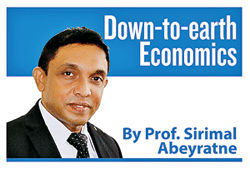Domestic debt optimisation
View(s):
Sri Lanka’s economy can recover if we are able to attract more tourists.
A few weeks ago, one of my former students sent me a text message asking a question: “Sir, my friends are withdrawing their bank deposits. They think that banks would collapse, and they would lose their money. I wonder whether I should withdraw my fixed deposits too. What do you think? Will the banks collapse?”
I sent a reply to the student saying: “When all depositors are going to withdraw their money, banks will collapse!” However, this was not the only occasion that the same question was raised for clarification by several persons in the recent past.
Similarly, there was another question that I heard often during the past few weeks by few of my friends and persons I met. It was about the risk of losing their retirement benefit of the Employees Provident Fund (EPF). The question is not surprising, as they were all expected to retire within the next couple of years.
After serving 30 – 40 years in the semi-government sector or the private sector, they have contributed to the EPF and other funds. These funds with their lifetime savings would give them a reasonable retirement benefit on which they expect to depend on for the rest of their living.
Hot topic of the week
The above questions got multiplied and intensified during the past few days, anticipating domestic debt restructuring. The declaration of the five-day bank holiday period looks as if there may be, actually a problem related to domestic debt restructuring.
Since this has become the hot topic of the week, I thought of dealing with it too which would help many of us to clear the confusion and to refute the opinion-based judgements. I must emphasise the fact that, however, I am resorting to official data and information for my discussion.
 Domestic public debt of Sri Lanka is over Rs. 15 trillion, apart from the country’s public debt from foreign sources. While negotiation for foreign debt restructuring is in progress, we have now unveiled a road map for domestic debt restructuring too. It is called debt optimisation rather than debt restructuring, because the term “optimisation” reflects a greater degree of flexibility to the lenders.
Domestic public debt of Sri Lanka is over Rs. 15 trillion, apart from the country’s public debt from foreign sources. While negotiation for foreign debt restructuring is in progress, we have now unveiled a road map for domestic debt restructuring too. It is called debt optimisation rather than debt restructuring, because the term “optimisation” reflects a greater degree of flexibility to the lenders.
Why do we need debt restructuring? The government has continued to borrow not only to cover the budget deficit, but also to repay previous borrowings – the gross financing needs – that the country must deal with every year. This means that we have borrowed too much, exceeding our repayment ability. Accordingly, Sri Lanka’s total debt stock, which now stands at 128 per cent of GDP is unsustainable. To make it sustainable, the government target is to bring it down to 95 per cent of GDP by 2032.
While we attempt to do so, the gross financing needs to cover the annual budget deficit and the debt repayment must be maintained too. As it has been estimated, this requirement, which is 16.8 per cent of GDP, is expected to fall to 14.2 per cent with foreign debt restructuring, and to 12.7 per cent with domestic debt restructuring, as an average for the period 2027-2032.
Lenders to the government
Who has lent to the government? Every institution and every person who hold government securities, Treasury bills and Treasury bonds, which are also called T-bills and T-bonds, have lent to the government. The institutions include Central Bank, commercial banks, non-bank institutions, and funds like the EPF. The persons include both Sri Lankans and foreign nationals who saved their money in government securities. From the government’s point of view, although it is borrowings, from the lenders’ point of view it is a financial investment or a saving so that they buy T-bills and T-bonds.
Out of the total Rs. 15 trillion domestic debt, Rs. 4.1 trillion consists of T-bills, and Rs. 8.7 trillion consists of T-bonds. T-bills are short-term debt instruments with maturity period less than a year, while T-bonds are long-term debt instruments with maturity period more than a year.
A large part of the T-bills is held by the banking sector with 62 per cent by the Central Bank, and 16 per cent by the commercial banks. On the other hand, a large part of T-bonds is held by the commercial banks with state banks alone keeping 33 per cent and the EPF alone 37 per cent of the total. The balance amounts of both T-bills and T-bonds are with the non-banking institutions such as non-bank financial institutions and corporates as well as individual persons.
Extending the maturity
The two major holders of government securities covered by the domestic debt restructuring are the Central Bank and the EPF. As the Central Bank is holding largely the short-term debt instruments, the T-bills, they will be converted to T-bonds.
This means an extension of the maturity period of the debt instruments, which would help the government to reduce the annual repayment obligation and to spread it over a longer period. This will affect four types of debt instruments maturing between 2029-2032, and six types of debt instruments maturing between 2033-2038. As the maturing period now gets extended, accordingly the coupon interest rate would fall too.
The same principle applies to T-bonds held by the EPF and other funds so that their current T-bonds will be replaced by new T-bonds with a longer maturity period. This will affect a basket of 12 debt instruments maturing from 2027-2038, while the coupon interest rate would be 12 per cent up to 2025, and 9 per cent until maturity. The effect of the extension of the maturity period will be the annual debt repayment obligations thinner and a spread of it over a longer period.
For EPF or other funds, there is an alternative option to pay higher tax at the rate raised from 14 per cent to 30 per cent on the income, which would reduce the interest income. There is no “haircut” on either the Central Bank-owned debt or the EPF-owned debt. A haircut means in a debt market, a cutdown in the value of debt which would reduce the value of the loan or the coupon interest.
There is no debt restructuring applied to the banking sector other than their dollar-denominated loans (based on International Sovereign Bonds – ISBs, and Sri Lanka Development Bonds – SLDBs, as the banking sector is already under stress at least due to three reasons: The first is that they are already paying higher taxes at the rate of around 50 per cent, while the second is that their non-performing loans have increased. Thirdly, they have also faced with the risk of customer speculations which would affect their operations.
EPF problem
The EPF problem that many of us are having is whether the retirement benefit would get affected by the extension of the maturity period of the T-bonds, held by the funds. It could be a possibility, if the EPF does not have enough funds to pay off the annual retirement benefits to all retiring employees.
The EPF is the largest fund in the country with about Rs.3 trillion assets contributed annually by 2.5 million active members as of 2021 data, while 93 per cent of the funds remain invested in government securities. If all the members decide to retire within the next couple of months and years, obviously there is a problem of paying the retirement benefits to everyone. This however doesn’t happen.
The number of refunds in 2021 has been 179,681, withdrawing Rs. 118 billion. At the same time, new members also join the EPF. Accordingly, member contributions have grown by 9.9 per cent and withdrawals by 7.7 per cent in 2021.
Would there be a reduction in interest income? This is not a new issue, because ups and downs in interest incomes are always a reality with interest rate movements. In the coming years, apparently, the interest rates are due to fall in response to the lower inflationary outlook of the economy so that the interest incomes of the EPF investments as well as bank deposits are due to fall too. In fact, the higher inflation in the recent past has already wiped out the real value of all our incomes, investments, and savings, which we need to understand. (The writer is a former Professor of Economics at the University of Colombo and can be reached at sirimal@econ.cmb.ac.lk and follow on Twitter @SirimalAshoka).
Hitad.lk has you covered with quality used or brand new cars for sale that are budget friendly yet reliable! Now is the time to sell your old ride for something more attractive to today's modern automotive market demands. Browse through our selection of affordable options now on Hitad.lk before deciding on what will work best for you!


